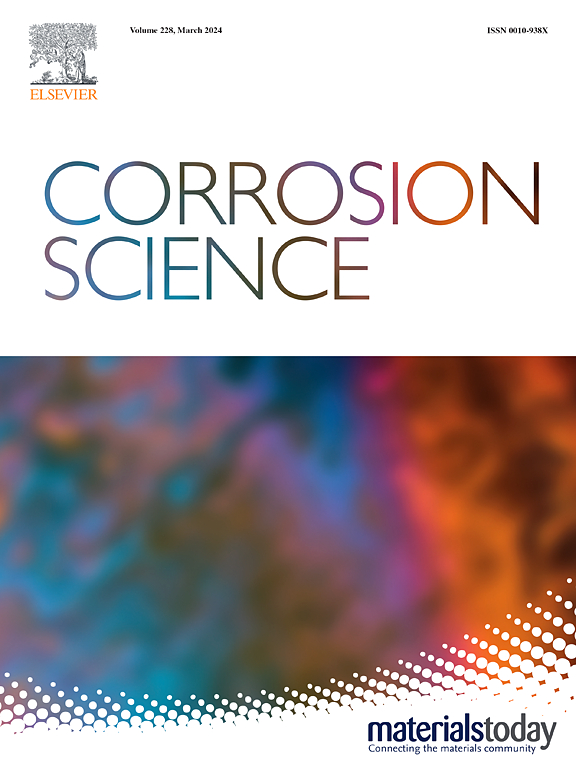海洋环境中保护Cu2O膜的氯诱导脱钝化机制的原子性见解
IF 7.4
1区 材料科学
Q1 MATERIALS SCIENCE, MULTIDISCIPLINARY
引用次数: 0
摘要
铜(Cu)由于其优异的导热性和导电性而被广泛应用于工业和海洋工程中。在碱性环境中,铜表面形成一层钝化层,主要由Cu2O组成,有效地抑制腐蚀。然而,在海洋环境中,这种保护膜变得容易受到侵略性Cl离子的攻击,导致膜分离。已经提出了几种解释Cu2O脱钝化的机制,包括应力诱导断裂、局部变薄和空洞诱导坍塌机制。然而,Cu2O/海水界面的精确原子尺度过程仍然知之甚少,留下Cl-促进Cu2O脱钝化的确切机制存在争议。为了阐明Cl-诱导Cu2O腐蚀的原子尺度机制,本研究采用了先进的计算技术:从头算热力学、机器学习基于势的分子动力学和约束分子动力学。我们的研究结果表明,在海洋条件下,Cl-在Cu2O(111)表面发生广泛的化学吸附。这种吸附显著降低了晶格铜溶解的能垒。此外,我们还证明了表面Cu+空位的形成速度远远超过它们在体中的纵向扩散速度。基于这种动力学差异,我们提出Cl-介导的Cu2O脱钝化主要通过局部变薄机制进行。总的来说,本研究阐明了铜表面钝化膜的击穿机理,为设计用于海洋环境的耐腐蚀铜基合金提供了重要的理论依据。本文章由计算机程序翻译,如有差异,请以英文原文为准。
Atomistic insights into chloride-induced depassivation mechanisms of protective Cu2O films in marine environments
Copper (Cu) is widely utilized in industrial and marine engineering due to its exceptional thermal and electrical conductivity. In alkaline environments, a passivation layer, primarily composed of Cu2O, forms on copper surfaces, effectively inhibiting corrosion. However, in marine environments, this protective film becomes vulnerable to attack by aggressive Cl- ions, leading to film detachment. Several mechanisms have been proposed to explain the depassivation of Cu2O, including stress-induced fracture, local thinning, and void-induced collapse mechanisms. Nevertheless, the precise atomic-scale processes at the Cu2O/seawater interface remain poorly understood, leaving the exact mechanism by which Cl- promotes Cu2O depassivation debated. To elucidate the atomic-scale mechanism of Cl--induced Cu2O corrosion, this study employs advanced computational techniques: ab initio thermodynamics, machine learning potential-based molecular dynamics, and constrained molecular dynamics. Our results reveal that under marine conditions, Cl- undergoes extensive chemisorption on the Cu2O(111) surface. This adsorption markedly reduces the energy barrier for lattice copper dissolution. Furthermore, we demonstrate that the formation rate of surface Cu+ vacancies far exceeds their longitudinal diffusion rate into the bulk. Based on this kinetic disparity, we propose that Cl--mediated Cu2O depassivation primarily proceeds via the local thinning mechanism. Overall, this work clarifies the breakdown mechanism of passive films on copper and provides a critical theoretical basis for designing corrosion-resistant Cu-based alloys used in marine environments.
求助全文
通过发布文献求助,成功后即可免费获取论文全文。
去求助
来源期刊

Corrosion Science
工程技术-材料科学:综合
CiteScore
13.60
自引率
18.10%
发文量
763
审稿时长
46 days
期刊介绍:
Corrosion occurrence and its practical control encompass a vast array of scientific knowledge. Corrosion Science endeavors to serve as the conduit for the exchange of ideas, developments, and research across all facets of this field, encompassing both metallic and non-metallic corrosion. The scope of this international journal is broad and inclusive. Published papers span from highly theoretical inquiries to essentially practical applications, covering diverse areas such as high-temperature oxidation, passivity, anodic oxidation, biochemical corrosion, stress corrosion cracking, and corrosion control mechanisms and methodologies.
This journal publishes original papers and critical reviews across the spectrum of pure and applied corrosion, material degradation, and surface science and engineering. It serves as a crucial link connecting metallurgists, materials scientists, and researchers investigating corrosion and degradation phenomena. Join us in advancing knowledge and understanding in the vital field of corrosion science.
 求助内容:
求助内容: 应助结果提醒方式:
应助结果提醒方式:


